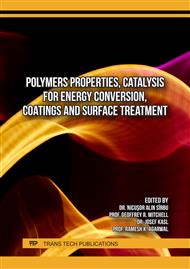p.3
p.9
p.19
p.25
p.31
p.41
p.53
p.59
Enhancing Antimicrobial and Irradiation-Shielding Properties of Poly(Butylene Succinate) Composites with Nanolignin for Active Biodegradable Packaging Applications
Abstract:
This study investigated the incorporation of lignin nanoparticles derived from black liquor (S-BLNAce) into polybutylene succinate (PBS) to enhance the antimicrobial and irradiation-shielding properties of PBS composite films for packaging applications. Black liquor, a by-product of paper industry, was utilized to produce nanolignin through acetone fractionation and anti-solvent precipitation techniques. PBS composite films with varying S-BLNAce concentrations (0.5–2.0%wt) were fabricated via blow-molding and evaluated for mechanical, irradiation-shielding, and antimicrobial properties. The addition of S-BLNAce nanolignin improved the tensile strength and modulus of PBS, particularly at lower concentrations, while slightly reducing elongation at break. Films with higher nanolignin content exhibited enhanced irradiation shielding, especially in the UV-A and UV-B regions, and demonstrated significant antibacterial activity against Escherichia coli and Staphylococcus aureus. These findings highlight the potential of nanolignin as a bio-based additive for developing high-performance, sustainable packaging materials, aligning with circular economy and sustainability goals.
Info:
Periodical:
Pages:
3-8
Citation:
Online since:
November 2025
Price:
Сopyright:
© 2025 Trans Tech Publications Ltd. All Rights Reserved
Share:
Citation:


